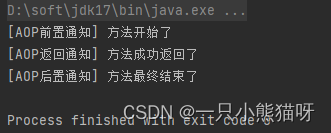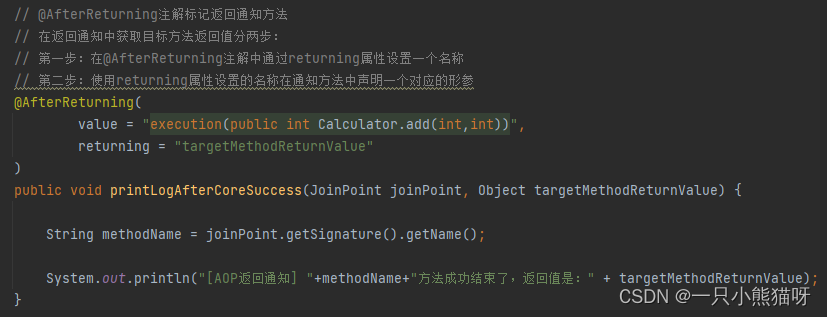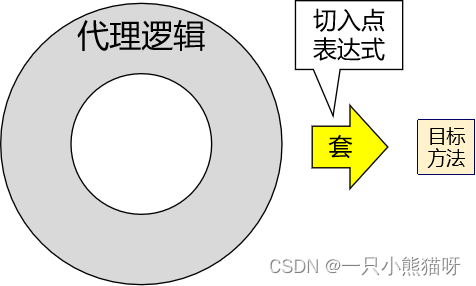五、Spring AOP面向切面编程(基于注解方式实现和细节)
本章概要
- Spring AOP底层技术组成
- 初步实现
- 获取通知细节信息
- 切点表达式语法
- 重用(提取)切点表达式
- 环绕通知
- 切面优先级设置
- CGLib动态代理生效
- 注解实现小结
5.5.1 Spring AOP 底层技术组成

- 动态代理(InvocationHandler):JDK原生的实现方式,需要被代理的目标类必须实现接口。因为这个技术要求代理对象和目标对象实现同样的接口(兄弟两个拜把子模式)。
- cglib:通过继承被代理的目标类(认干爹模式)实现代理,所以不需要目标类实现接口。
- AspectJ:早期的AOP实现的框架,SpringAOP借用了AspectJ中的AOP注解。
5.5.2 初步实现
- 加入依赖
<!-- spring-aspects会帮我们传递过来aspectjweaver -->
<dependency>
<groupId>org.springframework</groupId>
<artifactId>spring-aop</artifactId>
<version>6.0.6</version>
</dependency>
<dependency>
<groupId>org.springframework</groupId>
<artifactId>spring-aspects</artifactId>
<version>6.0.6</version>
</dependency>
- 准备接口
public interface Calculator {
int add(int i, int j);
int sub(int i, int j);
int mul(int i, int j);
int div(int i, int j);
}
- 纯净实现类package com.atguigu.proxy;
/**
* 实现计算接口,单纯添加 + - * / 实现! 掺杂其他功能!
*/
@Component
public class CalculatorPureImpl implements Calculator {
@Override
public int add(int i, int j) {
int result = i + j;
return result;
}
@Override
public int sub(int i, int j) {
int result = i - j;
return result;
}
@Override
public int mul(int i, int j) {
int result = i * j;
return result;
}
@Override
public int div(int i, int j) {
int result = i / j;
return result;
}
}
- 声明切面类
import org.aspectj.lang.annotation.*;
import org.springframework.stereotype.Component;
// @Aspect表示这个类是一个切面类
@Aspect
// @Component注解保证这个切面类能够放入IOC容器
@Component
public class LogAspect {
// @Before注解:声明当前方法是前置通知方法
// value属性:指定切入点表达式,由切入点表达式控制当前通知方法要作用在哪一个目标方法上
@Before(value = "execution(public int com.atguigu.proxy.CalculatorPureImpl.add(int,int))")
public void printLogBeforeCore() {
System.out.println("[AOP前置通知] 方法开始了");
}
@AfterReturning(value = "execution(public int com.atguigu.proxy.CalculatorPureImpl.add(int,int))")
public void printLogAfterSuccess() {
System.out.println("[AOP返回通知] 方法成功返回了");
}
@AfterThrowing(value = "execution(public int com.atguigu.proxy.CalculatorPureImpl.add(int,int))")
public void printLogAfterException() {
System.out.println("[AOP异常通知] 方法抛异常了");
}
@After(value = "execution(public int com.atguigu.proxy.CalculatorPureImpl.add(int,int))")
public void printLogFinallyEnd() {
System.out.println("[AOP后置通知] 方法最终结束了");
}
}
- 开启 aspectj 注解支持
- xml方式
<?xml version="1.0" encoding="UTF-8"?>
<beans xmlns="http://www.springframework.org/schema/beans"
xmlns:xsi="http://www.w3.org/2001/XMLSchema-instance"
xmlns:context="http://www.springframework.org/schema/context"
xmlns:aop="http://www.springframework.org/schema/aop"
xsi:schemaLocation="http://www.springframework.org/schema/beans http://www.springframework.org/schema/beans/spring-beans.xsd http://www.springframework.org/schema/context https://www.springframework.org/schema/context/spring-context.xsd http://www.springframework.org/schema/aop https://www.springframework.org/schema/aop/spring-aop.xsd">
<!-- 进行包扫描-->
<context:component-scan base-package="com.atguigu" />
<!-- 开启aspectj框架注解支持-->
<aop:aspectj-autoproxy />
</beans>
- 配置类方式
@Configuration
@ComponentScan(basePackages = "com.atguigu")
//作用等于 <aop:aspectj-autoproxy /> 配置类上开启 Aspectj注解支持!
@EnableAspectJAutoProxy
public class MyConfig {
}
- 测试效果
//@SpringJUnitConfig(locations = "classpath:spring-aop.xml")
@SpringJUnitConfig(value = {MyConfig.class})
public class AopTest {
@Autowired
private Calculator calculator;
@Test
public void testCalculator(){
calculator.add(1,1);
}
}
输出结果:

5.5.3 获取通知细节信息
- JointPoint 接口
需要获取方法签名、传入的实参等信息时,可以在通知方法声明JoinPoint类型的形参。
- 要点1:JoinPoint 接口通过 getSignature() 方法获取目标方法的签名(方法声明时的完整信息)
- 要点2:通过目标方法签名对象获取方法名
- 要点3:通过 JoinPoint 对象获取外界调用目标方法时传入的实参列表组成的数组
JointPoint.java
public class JointPoint {
// @Before注解标记前置通知方法
// value属性:切入点表达式,告诉Spring当前通知方法要套用到哪个目标方法上
// 在前置通知方法形参位置声明一个JoinPoint类型的参数,Spring就会将这个对象传入
// 根据JoinPoint对象就可以获取目标方法名称、实际参数列表
@Before(value = "execution(public int com.atguigu.aop.api.Calculator.add(int,int))")
public void printLogBeforeCore(JoinPoint joinPoint) {
// 1.通过JoinPoint对象获取目标方法签名对象
// 方法的签名:一个方法的全部声明信息
Signature signature = joinPoint.getSignature();
// 2.通过方法的签名对象获取目标方法的详细信息
String methodName = signature.getName();
System.out.println("methodName = " + methodName);
int modifiers = signature.getModifiers();
System.out.println("modifiers = " + modifiers);
String declaringTypeName = signature.getDeclaringTypeName();
System.out.println("declaringTypeName = " + declaringTypeName);
// 3.通过JoinPoint对象获取外界调用目标方法时传入的实参列表
Object[] args = joinPoint.getArgs();
// 4.由于数组直接打印看不到具体数据,所以转换为List集合
List<Object> argList = Arrays.asList(args);
System.out.println("[AOP前置通知] " + methodName + "方法开始了,参数列表:" + argList);
}
}
- 方法返回值
在返回通知中,通过 @AfterReturning 注解的 returning 属性获取目标方法的返回值!

import org.aspectj.lang.JoinPoint;
import org.aspectj.lang.annotation.*;
import org.springframework.stereotype.Component;
// @Aspect表示这个类是一个切面类
@Aspect
// @Component注解保证这个切面类能够放入IOC容器
@Component
public class LogAspect {
// @Before注解:声明当前方法是前置通知方法
// value属性:指定切入点表达式,由切入点表达式控制当前通知方法要作用在哪一个目标方法上
@Before(value = "execution(public int com.atguigu.CalculatorPureImpl.add(int,int))")
public void printLogBeforeCore() {
System.out.println("[AOP前置通知] 方法开始了");
}
@AfterReturning(value = "execution(public int com.atguigu.CalculatorPureImpl.add(int,int))")
public void printLogAfterSuccess() {
System.out.println("[AOP返回通知] 方法成功返回了");
}
// @AfterReturning注解标记返回通知方法
// 在返回通知中获取目标方法返回值分两步:
// 第一步:在@AfterReturning注解中通过returning属性设置一个名称
// 第二步:使用returning属性设置的名称在通知方法中声明一个对应的形参
@AfterReturning(
value = "execution(public int Calculator.add(int,int))",
returning = "targetMethodReturnValue"
)
public void printLogAfterCoreSuccess(JoinPoint joinPoint, Object targetMethodReturnValue) {
String methodName = joinPoint.getSignature().getName();
System.out.println("[AOP返回通知] "+methodName+"方法成功结束了,返回值是:" + targetMethodReturnValue);
}
@AfterThrowing(value = "execution(public int com.atguigu.CalculatorPureImpl.add(int,int))")
public void printLogAfterException() {
System.out.println("[AOP异常通知] 方法抛异常了");
}
@After(value = "execution(public int com.atguigu.CalculatorPureImpl.add(int,int))")
public void printLogFinallyEnd() {
System.out.println("[AOP后置通知] 方法最终结束了");
}
}
- 异常对象捕捉
在异常通知中,通过@AfterThrowing注解的throwing属性获取目标方法抛出的异常对象

package com.atguigu;
import org.aspectj.lang.JoinPoint;
import org.aspectj.lang.annotation.*;
import org.springframework.stereotype.Component;
// @Aspect表示这个类是一个切面类
@Aspect
// @Component注解保证这个切面类能够放入IOC容器
@Component
@SuppressWarnings("all")
public class LogAspect {
// @Before注解:声明当前方法是前置通知方法
// value属性:指定切入点表达式,由切入点表达式控制当前通知方法要作用在哪一个目标方法上
@Before(value = "execution(public int com.atguigu.CalculatorPureImpl.add(int,int))")
public void printLogBeforeCore() {
System.out.println("[AOP前置通知] 方法开始了");
}
@AfterReturning(value = "execution(public int com.atguigu.CalculatorPureImpl.add(int,int))")
public void printLogAfterSuccess() {
System.out.println("[AOP返回通知] 方法成功返回了");
}
// @AfterReturning注解标记返回通知方法
// 在返回通知中获取目标方法返回值分两步:
// 第一步:在@AfterReturning注解中通过returning属性设置一个名称
// 第二步:使用returning属性设置的名称在通知方法中声明一个对应的形参
@AfterReturning(
value = "execution(public int Calculator.add(int,int))",
returning = "targetMethodReturnValue"
)
public void printLogAfterCoreSuccess(JoinPoint joinPoint, Object targetMethodReturnValue) {
String methodName = joinPoint.getSignature().getName();
System.out.println("[AOP返回通知] "+methodName+"方法成功结束了,返回值是:" + targetMethodReturnValue);
}
@AfterThrowing(value = "execution(public int com.atguigu.CalculatorPureImpl.add(int,int))")
public void printLogAfterException() {
System.out.println("[AOP异常通知] 方法抛异常了");
}
// @AfterThrowing注解标记异常通知方法
// 在异常通知中获取目标方法抛出的异常分两步:
// 第一步:在@AfterThrowing注解中声明一个throwing属性设定形参名称
// 第二步:使用throwing属性指定的名称在通知方法声明形参,Spring会将目标方法抛出的异常对象从这里传给我们
@AfterThrowing(
value = "execution(public int Calculator.add(int,int))",
throwing = "targetMethodException"
)
public void printLogAfterCoreException(JoinPoint joinPoint, Throwable targetMethodException) {
String methodName = joinPoint.getSignature().getName();
System.out.println("[AOP异常通知] "+methodName+"方法抛异常了,异常类型是:" + targetMethodException.getClass().getName());
}
@After(value = "execution(public int com.atguigu.CalculatorPureImpl.add(int,int))")
public void printLogFinallyEnd() {
System.out.println("[AOP后置通知] 方法最终结束了");
}
}
5.5.4 切点表达式语法
- 切点表达式作用
AOP切点表达式(Pointcut Expression)是一种用于指定切点的语言,它可以通过定义匹配规则,来选择需要被切入的目标对象。

- 切点表达式语法
切点表达式总结

语法细节
- 第一位:execution( ) 固定开头
- 第二位:方法访问修饰符
public private 直接描述对应修饰符即可
- 第三位:方法返回值
int String void 直接描述返回值类型
注意:
特殊情况 不考虑 访问修饰符和返回值
execution(* * ) 这是错误语法
execution( *) == 你只要考虑返回值 或者 不考虑访问修饰符 相当于全部不考虑了
- 第四位:指定包的地址
固定的包: com.atguigu.api | service | dao
单层的任意命名: com.atguigu.* = com.atguigu.api com.atguigu.dao * = 任意一层的任意命名
任意层任意命名: com.. = com.atguigu.api.erdaye com.a.a.a.a.a.a.a ..任意层,任意命名 用在包上!
注意: ..不能用作包开头 public int .. 错误语法 com..
找到任何包下: *..
- 第五位:指定类名称
固定名称: UserService
任意类名: *
部分任意: com..service.impl.*Impl
任意包任意类: *..*
- 第六位:指定方法名称
语法和类名一致
任意访问修饰符,任意类的任意方法: * *..*.*
- 第七位:方法参数
具体值: (String,int) != (int,String) 没有参数 ()
模糊值: 任意参数 有 或者 没有 (..) ..任意参数的意识
部分具体和模糊:
第一个参数是字符串的方法 (String..)
最后一个参数是字符串 (..String)
字符串开头,int结尾 (String..int)
包含int类型(..int..)
- 切点表达式案例
1.查询某包某类下,访问修饰符是公有,返回值是int的全部方法
2.查询某包下类中第一个参数是String的方法
3.查询全部包下,无参数的方法!
4.查询com包下,以int参数类型结尾的方法
5.查询指定包下,Service开头类的私有返回值int的无参数方法
5.5.5 重用(提取)切点表达式
- 重用切点表达式优点
// @Before注解:声明当前方法是前置通知方法
// value属性:指定切入点表达式,由切入点表达式控制当前通知方法要作用在哪一个目标方法上
@Before(value = "execution(public int com.atguigu.proxy.CalculatorPureImpl.add(int,int))")
public void printLogBeforeCore() {
System.out.println("[AOP前置通知] 方法开始了");
}
@AfterReturning(value = "execution(public int com.atguigu.proxy.CalculatorPureImpl.add(int,int))")
public void printLogAfterSuccess() {
System.out.println("[AOP返回通知] 方法成功返回了");
}
@AfterThrowing(value = "execution(public int com.atguigu.proxy.CalculatorPureImpl.add(int,int))")
public void printLogAfterException() {
System.out.println("[AOP异常通知] 方法抛异常了");
}
@After(value = "execution(public int com.atguigu.proxy.CalculatorPureImpl.add(int,int))")
public void printLogFinallyEnd() {
System.out.println("[AOP后置通知] 方法最终结束了");
}
上面案例,是我们之前编写切点表达式的方式,发现, 所有增强方法的切点表达式相同!
出现了冗余,如果需要切换也不方便统一维护!
我们可以将切点提取,在增强上进行引用即可!
- 同一类内部引用
提取
// 切入点表达式重用
@Pointcut("execution(public int com.atguigu.aop.api.Calculator.add(int,int)))")
public void declarPointCut() {}
注意:提取切点注解使用@Pointcut(切点表达式) , 需要添加到一个无参数无返回值方法上即可!
引用
@Before(value = "declarPointCut()")
public void printLogBeforeCoreOperation(JoinPoint joinPoint) {
- 不同类中引用
不同类在引用切点,只需要添加类的全限定符+方法名即可!
@Before(value = "com.atguigu.spring.aop.aspect.LogAspect.declarPointCut()")
public Object roundAdvice(ProceedingJoinPoint joinPoint) {
- 切点统一管理
建议:将切点表达式统一存储到一个类中进行集中管理和维护!
@Component
public class AtguiguPointCut {
@Pointcut(value = "execution(public int *..Calculator.sub(int,int))")
public void atguiguGlobalPointCut(){}
@Pointcut(value = "execution(public int *..Calculator.add(int,int))")
public void atguiguSecondPointCut(){}
@Pointcut(value = "execution(* *..*Service.*(..))")
public void transactionPointCut(){}
}
5.5.6 环绕通知
环绕通知对应整个 try…catch…finally 结构,包括前面四种通知的所有功能。
// 使用@Around注解标明环绕通知方法
@Around(value = "com.atguigu.aop.aspect.AtguiguPointCut.transactionPointCut()")
// 通过在通知方法形参位置声明ProceedingJoinPoint类型的形参,
// Spring会将这个类型的对象传给我们
public Object manageTransaction(ProceedingJoinPoint joinPoint) {
// 通过ProceedingJoinPoint对象获取外界调用目标方法时传入的实参数组
Object[] args = joinPoint.getArgs();
// 通过ProceedingJoinPoint对象获取目标方法的签名对象
Signature signature = joinPoint.getSignature();
// 通过签名对象获取目标方法的方法名
String methodName = signature.getName();
// 声明变量用来存储目标方法的返回值
Object targetMethodReturnValue = null;
try {
// 在目标方法执行前:开启事务(模拟)
log.debug("[AOP 环绕通知] 开启事务,方法名:" + methodName + ",参数列表:" + Arrays.asList(args));
// 过ProceedingJoinPoint对象调用目标方法
// 目标方法的返回值一定要返回给外界调用者
targetMethodReturnValue = joinPoint.proceed(args);
// 在目标方法成功返回后:提交事务(模拟)
log.debug("[AOP 环绕通知] 提交事务,方法名:" + methodName + ",方法返回值:" + targetMethodReturnValue);
} catch (Throwable e) {
// 在目标方法抛异常后:回滚事务(模拟)
log.debug("[AOP 环绕通知] 回滚事务,方法名:" + methodName + ",异常:" + e.getClass().getName());
} finally {
// 在目标方法最终结束后:释放数据库连接
log.debug("[AOP 环绕通知] 释放数据库连接,方法名:" + methodName);
}
return targetMethodReturnValue;
}
5.5.7 切面优先级设置
相同目标方法上同时存在多个切面时,切面的优先级控制切面的内外嵌套顺序。
- 优先级高的切面:外面
- 优先级低的切面:里面
使用 @Order 注解可以控制切面的优先级:
- @Order(较小的数):优先级高
- @Order(较大的数):优先级低

实际意义
实际开发时,如果有多个切面嵌套的情况,要慎重考虑。例如:如果事务切面优先级高,那么在缓存中命中数据的情况下,事务切面的操作都浪费了。

此时应该将缓存切面的优先级提高,在事务操作之前先检查缓存中是否存在目标数据。

5.5.8 CGLib 动态代理生效
在目标类没有实现任何接口的情况下,Spring会自动使用cglib技术实现代理。为了证明这一点,我们做下面的测试:
@Service
public class EmployeeService {
public void getEmpList() {
System.out.print("方法内部 com.atguigu.aop.imp.EmployeeService.getEmpList");
}
}
测试:
@Autowired
private EmployeeService employeeService;
@Test
public void testNoInterfaceProxy() {
employeeService.getEmpList();
}
没有接口:

有接口:

使用总结:
- 如果目标类有接口,选择使用jdk动态代理
- 如果目标类没有接口,选择cglib动态代理
- 如果有接口,接口接值
- 如果没有接口,类进行接值
5.5.9 注解实现小结

本文来自互联网用户投稿,该文观点仅代表作者本人,不代表本站立场。本站仅提供信息存储空间服务,不拥有所有权,不承担相关法律责任。 如若内容造成侵权/违法违规/事实不符,请联系我的编程经验分享网邮箱:veading@qq.com进行投诉反馈,一经查实,立即删除!